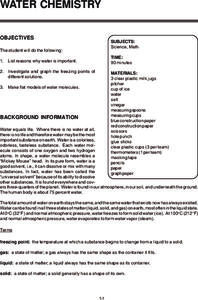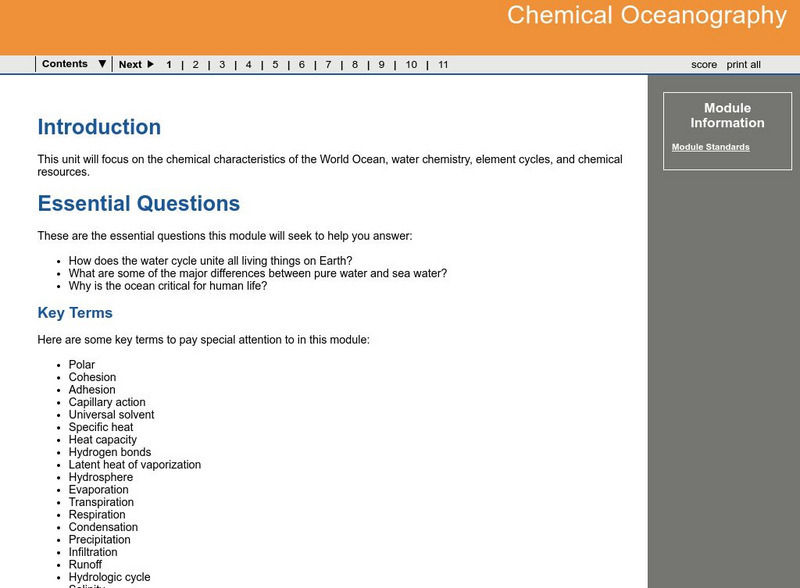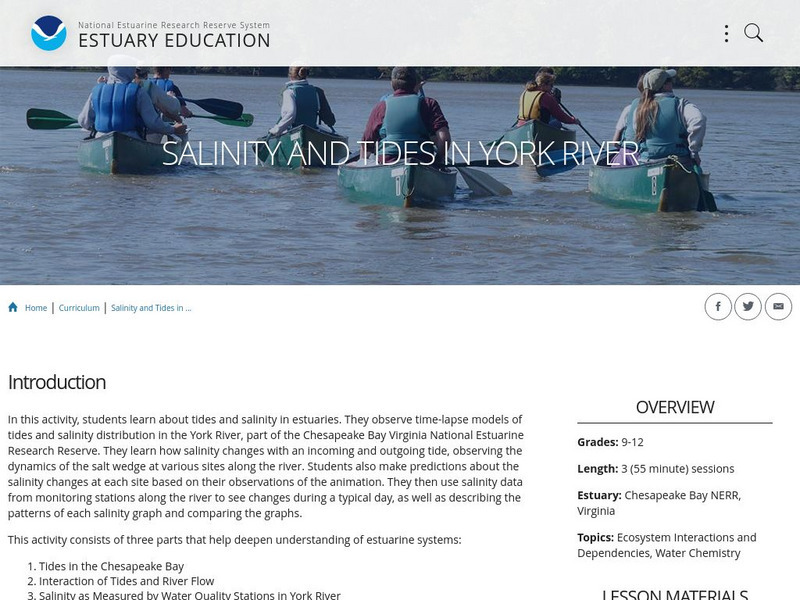Curated OER
Great Lakes Ecology
High schoolers are able to use a secchi disk to measure the turbidity of water by determining the depth at which the sechi disk is no longer visible and using the data in a formula to quantify the results. They are able to use Vernier...
Curated OER
What is Wrong with My Pond?
Students examine various pond water samples to identify water quality. In this water quality lesson, students will identify levels of nitrates, ammonia, pH, hardness,and alkalinity in pond water. They will explain importance of water...
Curated OER
WATER CHEMISTRY
Students list reasons why water is important and investigate and graph the freezing points of different solutions.
Curated OER
Stream Chemistry Monitoring
Students become familiar with real-world gathering of chemical data. The experience how the science is done: the nature of analysis, data collection, interpretation, and presentation. They study a nearby body of water for their experiment.
Georgia Department of Education
Ga Virtual Learning: Chemical Oceanography
Students study the chemical characteristics of the World Ocean, water chemistry, element cycles, and chemical resources in this multi-media learning module.
National Geographic
National Geographic: Human Impacts on Marine Species
Students learn about three examples of human impacts on marine life: migration patterns and shipping, algal blooms and water chemistry, and marine debris. Some of these impacts are due to human activity in the ocean, and some impacts on...
NOAA
Noaa: Estuaries 101 Curriculum: Dissolved Oxygen in an Estuary
In this activity, students focus on the relationship between dissolved oxygen, plant growth, chlorophyll-a and temperature using SWMP water quality data from monitoring stations in the Narragansett Bay Estuarine Research Reserve and the...
NOAA
Noaa: Estuaries 101 Curriculum: Extreme Weather and Estuaries
Students investigate how hurricanes can affect National Estuarine Research Reserve System estuaries. This activity consists of 2 parts which help deepen understanding of estuarine systems: Investigating an Estuary and Impact of Extreme...
NOAA
Noaa: Estuaries 101 Curriculum: Human Impact on Estuaries
Students will make a model of a pollution spill that occurred at Bangs Lake, a tidal lake within the Grand Bay National Estuarine Research Reserve in Mississippi, in April 2005, and measure water quality parameters in their model....
NOAA
Noaa: Estuaries 101 Curriculum: Salinity and Tides in York River
In this learning activity, students explore tides and salinity from tidal freshwater to high salinity conditions along the York River estuary. They learn how salinity changes with an incoming and outgoing tide, observing the dynamics of...
NOAA
Noaa: Estuaries 101 Curriculum: Survival in an Estuary
This activity introduces students to the nature of estuaries, estuarine environmental factors, and four important abiotic factors-pH, temperature, dissolved oxygen, and salinity-and how they vary in estuaries. A PowerPoint presentation,...
NOAA
Noaa: Estuaries 101 Curriculum: Nutrients in an Estuary
An overload of nutrients, called eutrophication (Greek for "good-nutrition"), can be harmful to estuaries. This phenomenon is also referred to as "over-enrichment," or "nutrient pollution". Students will investigate the range of...
Science Education Resource Center at Carleton College
Serc: Coupled Plasma Mass Spectrometer to Teach About Water Chemistry
In this lesson plan learners will use data acquired with an ICP-MS to teach them about water chemistry at a variety of levels.














